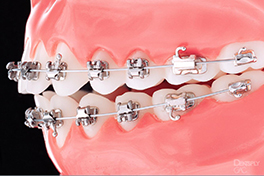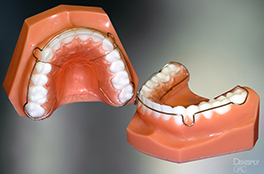Braces
 Braces use constant, gentle pressure, which over time, move teeth into their proper positions. Your braces are at work every moment of your orthodontic treatment. The two main components of your braces are: the brackets that are placed on your teeth and the main archwire that connects them. The bracket is a piece of shaped metal or ceramic that we affix to each tooth. The archwire is bent to reflect your "ideal" bite. In other words, it reflects the way we want you to look after treatment.
Braces use constant, gentle pressure, which over time, move teeth into their proper positions. Your braces are at work every moment of your orthodontic treatment. The two main components of your braces are: the brackets that are placed on your teeth and the main archwire that connects them. The bracket is a piece of shaped metal or ceramic that we affix to each tooth. The archwire is bent to reflect your "ideal" bite. In other words, it reflects the way we want you to look after treatment.
The wire threads through the brackets. As the wire tries to return to its original shape, it applies pressure to move your teeth. Picture your tooth resting in your jaw bone. With pressure on one side from the archwire, the bone on the other side gives way. The tooth moves. New bone grows in behind.
Attached to your braces, elastics (rubber bands) exert the proper force that creates the right amount of pressure to move teeth. In order for this force to remain constant, elastics must be worn all the time and changed every day.
Different Types of Braces
Metal braces are the most popular with kids and teenagers. They love using different colors of ligature ties. These braces are much smaller than ever before.
Ceramic Braces are are not as visible as metal braces. Ceramic braces are a little more expensive and they’re not as strong as metal braces, but they look great.
Lingual Braces are attached behind the teeth so they’re not visible when you smile. Lingal braces are also more expensive than traditional metal braces but the advantages are apparent.
Self-Ligating metal brackets reduce friction between brackets and wires by eliminating use of ligature ties. Thus, it can reduce total treatment time.
Removable Appliances
Removable appliances, unlike conventional braces, are used to retain teeth in their corrected positions and in some cases, to influence growth of the jaws in order to effect changes in facial structure. In addition, they are often used before and in conjunction with fixed appliances.
Removable appliances are not utilized to treat all orthodontic problems. It takes skill, and experience to recognize conditions that will respond favorably to removable appliances. Timing of such therapy also is very important.
Since removable appliances can easily be taken out by the patient, there may be a tendency not to wear them as we have prescribed. This means your teeth, jaws and muscles may move back toward their original positions.
Removable appliances require care. Although you may notice an effect on eating and speaking along with an increase in the flow of saliva, you will eventually adjust to the appliance.
Invisalign
The invisible way to straighten your teeth without braces, Invisalign uses a series of clear removable aligners to straighten your teeth without metal wires or brackets.
The aligners are made through a combination of your orthodontist's expertise and 3-D computer imaging technology.
You wear each set of aligners for about 2 weeks, removing them only to eat, drink, brush, and floss.
As you replace each aligner with the next in the series, your teeth will move - little by little, week by week - until they have straightened to the final position your orthodontist has prescribed.
You'll visit Dr. Ding about once every 6 weeks to ensure that your treatment is progressing as planned.
For more information on Invisalign, please visit www.invisalign.com.
Total treatment time averages 9 - 15 months and the average number of aligners worn during treatment is between 18 and 30, but both will vary from case to case.
To discuss Invisalign, please feel free to contact us to schedule an appointment.
Headgear
 Orthodontic headgear is a very important part of the treatment for some patients. Headgear creates forces that guide the growth of the face and jaws. It also is used to move teeth into better positions or to prevent teeth from moving.
Orthodontic headgear is a very important part of the treatment for some patients. Headgear creates forces that guide the growth of the face and jaws. It also is used to move teeth into better positions or to prevent teeth from moving.
Maintaining constant use of your headgear will achieve the best results. If instructions on usage are not followed, treatment will take longer and our treatment plan may have to change.
If the headgear is removed carelessly, the part that fits in your mouth and attaches to your teeth could injure your lips, cheeks, face and possibly your eyes.
Never remove the headgear until the straps have been disconnected.
Never lift the headgear over your face.
Never wear the headgear when running or playing sports.
Retainers
 Once the active period is completed, your braces are removed. The next step is called retention. Retainers are utilized to hold your teeth in their new positions until your bone, gums, and muscles adapt to the new teeth positions. You must wear your retainer as instructed, otherwise your teeth may move toward their original positions and the benefit of wearing your braces will be lost.
Once the active period is completed, your braces are removed. The next step is called retention. Retainers are utilized to hold your teeth in their new positions until your bone, gums, and muscles adapt to the new teeth positions. You must wear your retainer as instructed, otherwise your teeth may move toward their original positions and the benefit of wearing your braces will be lost.
Your doctor will determine how long you need to wear your retainer. Time varies with each patient. Some people may need retainers for an extended period of time in order to eliminate shifting of the teeth. In some cases, permanent retention may be necessary. The retention period is an important part of your overall treatment and should not be neglected!
The new type of retainers that we use are clear aligners similar to invisalign trays.
Remember, wear them in your mouth, not in your pocket. Retainers work when you follow our instructions.
Handle your retainers with care. Retainers are easy to lose. If you take your retainers out, always place them in your retainer case for safety.





 21 Bay State Road, Boston MA
21 Bay State Road, Boston MA


